
Home
- Artifacts
- Buildings & Businesses
- Churches
- Holidays & Celebrations
- Counties/Locations
- Delta College
- Early Settlers
- Ethnic Background
- Local, Michigan, U.S. and World Events
- Family Genealogy
- Farming
- Libraries & Museums
- Local Sites
- Logging
- Musicians, Artists & Famous People
- Nature, Weather & Four Seasons
- Railroads
- Schools
- Sports
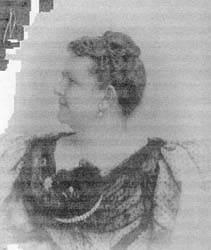 |
Martha Hay was as outstanding woman of her time. Martha accomplished tasks in the late 1800s that most women of her time never would have. After her first husband's death in 1881 she raised her seven children alone for fifteen years. She ran her husband's company and became a member of an all men's club, The Tittabawassee Boom Company. Martha also registered log marks in her name (Strobel). "She was prominent socially and was a leading member of the First Presbyterian Church" ("Pioneer")
Martha Amy Hawkins was born November 7, 1847, in Dixboro, Michigan, according to Martha's marriage record (See Appendix 1). Her mother's name was Mary Ann Doyle, and her father was Jabez Hawkins, according to the church of Jesus Christ of Latter Day Saints. Martha and her parents moved to Elm Hall, Michigan, where she met her first husband James Hay ("Pioneer"). They moved to Saginaw, Michigan, where they got married on December 13, 1864. Martha was also known as Mattie Hawkins and Mary Hay. Martha's parents are buried at the Hay family plot at Oakwood Cemetery. Mary and Jabez were natives of Vermont and Ohio. They were a very prominent family (Mills 370).
James Hay was born May 10, 1864 in Scotland (See Appendix 2). When he was younger he moved to New York with his father, Daniel Hay. James was the third child of seven sons. He moved to Saginaw in 1857, where he got a job as a foreman at a lumber mill. James became a partner in a lumbering company with Ezra Rust in 1859, under the name of Rust & Hay. The Company handled about ten million feet of logs a year. Rust, Easton & Co. was formed in 1865. The partners were Amasa Rust, George L. Burrows, D. L. C. Eaton, James Hay, Ezra Rust, and A. S. Gaylord. The mill was located in Zilwaukee, and they later extracted salt works. The firm of Hay, Butman & Co. was formed in 1871. The mill operation was in Bay City, and they also extracted salt (Mills 369).
James played a leadership role in the workings of the lumber firm. James was not a very educated man, but was very smart when it came to business. James was a Director of the Tittabawassee Boom Company from 1876-1879. In 1879 he was appointed by the board of directors President of the firm (Mills 369). James Hay was involved in financing and helping to build a railroad in Saginaw County; it was Saginaw Valley & St. Louis. It was the shortest railroad in the state. The grand opening of the railroad was December 31, 1872. In the first year of business the railroad made $150,000.00. The railroad later extended and traveled almost anywhere in the lower state. It was later joined with the Flint & Pere Marquette. James Hay also owned a farm in Clair County, Section 34 of Grant (History 728).
Martha and James had nine children according to the genealogical records of The Church of Jesus Christ of Later Day Saints: James Hay, Mary Wetherell Hay, Will Greive Hay, Jane Hawkins Hay, Martha Doyle Hay, Alice Merrill Hay, Ethel Rust Hay, Blanche Palmer Hay, Nina James Hay. James and Alice preceded their parents in death (See Appendix 3).
Martha put on lavish weddings for her children. Newspaper articles called them the social events of the season. The wedding of Lewis Ramsey and Nina Hay made an article in the newspaper. About two hundred guests were at the wedding. The house was decorated in green with wedding bells. There was an orchestra playing music all through the wedding. The flowers that were at the wedding were rare flowers. Martha put on weddings for most of her children at her house ("Hay-Ramsey").
James and Martha's children enjoyed all the advantages that wealth can bring. Her children were able to become well educated and had chances to travel to places that ordinary people would not be able to. Nina Hay was in the newspaper for buying a brand new car, one of the best and fastest at the time. She told the paper that she planned on making a trip to Atlantic City with her mother ("To Atlantic City").
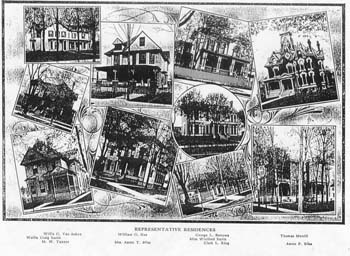 |
Martha and her family lived at 601 Washington, which would be known as 604 South Michigan, the corner of Michigan and Lyon. Martha's son Will Hay sold the house to a woman who had the house moved to the corner of Webster and Ames street (See Appendix 4). Martha was a lady with great taste. Martha had a house built at 400 South Michigan. It took about two years for the construction of the house. The house was constructed according to most recent architecture and style of that time and was also furnished with the best (Mills 370). The house was a Victorian style with a wrap-around porch, four stories high, with a garden room on the fourth floor. There were servants' quarters in the back. In the front of the house there was a foyer with marble floor. When a visitor would walk in the front door he would see the great room, then the living room, and then a den in the rear that overlooked the Saginaw River. There was a stairway to the second floor. The master bedroom was located facing the road and the river. The balcony overlooked the river. The room was very spacious and had a private bath. Down the hall were other rooms, and they had their own bath to share. The third floor had additional bedrooms and a sewing room. Then on the fourth floor was the garden room, all enclosed in glass all around including the roof. The house was all trimmed out in fine oak and maple trim. Her house is no longer standing; there is a Chinese restaurant at this site (See Appendix 5).
James and Martha were members of the First Presbyterian Church. The Church is located between Adams and Cass on South Michigan. James Hay is listed as a trustee in 1874 (History 322). The First Presbyterian Church of Saginaw anniversary book lists James Hay as having subscribed for pews in 1869. Martha is listed as a charter member during the celebration of the Silver Anniversary of the Foreign Missionary Society (Presbyterian 35, 91)
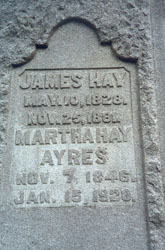 |
James died November 25, 1881. When James was laid to rest there was an article in the paper, and it made the front page. His will stated:
I give devise and bequeath unto my beloved wife Mattie A. Hay all my right and title and interest being an equal undivided one sixth part of in and to all the real estate which I now own and which I may here after acquire and shall at the time of my decease own in common or as a partner with Ezra Rust, Amasa Rust, Daniel L. C. Eaton, George L. Burrows and Augustine S. Gaylord or their or either of their heirs or assigns. And also all my right and title an interest in and to o all personal property of every kind name nature and description which shall at the time of my decease belong to the firm of Rust, Eaton & Co. (See Appendix 6)
After inheriting James' shares of the company, Martha became a member of the Tittabawassee Boom Company. She was the only female ever known to be a part of this all men's club (Kilar). Martha had three registered log marks with the company (Tittabawassee). (See Appendix 7). Martha was also left to run the rest of family businesses as well. Martha was a remarkable businesswoman. There were men who were accused of cutting and steeling logs from the Hay family farm, and Martha took them to court. There were also men who were accused of steeling logs on property owned by Ezra Rust, Martha Hay, Will Hay, and Jane Rust; the property was section 22 of Grant (east of Bud Lake). Joseph Dow was accused of stealing seventy-five cork pines; he was fined and let go (Meek 218-20).
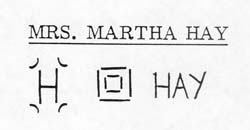 |
On March 17, 1896, Martha was married to Ebenenezer R. Ayres. E. R. who was born in New York. The marriage certificate is on file at the Saginaw County Court House (Record # J-5878). Ebenenezer owned Ayres Lumber and Salt Company. The company was incorporated January 1, 1891. The mill was located at 1689 S. Washington Avenue, East Side, Saginaw. In the Saginaw Directory 1893-1894, the company's capital was listed at 100,000 dollars.
Martha had a long-term maid, Emma Conzelman. Emma was Martha's personal companion. She traveled with Martha and was always by her side. Emma was petitioned to court in Los Angeles, California, to give a deposition to find out if Martha was in her right mind when she made out her will. She talked very highly of Martha. She was telling about how she handled all of her own business affairs.
Martha was a very organized woman. In Martha's will she had everything in the order that she wanted everyone to receive it. She even had all of her rugs numbered. Martha had her will very organized. She has exact descriptions of everything, for example: "1 Ring- 2 large diamonds, one slightly yellow with small diamonds on either side". Martha's will was twenty-two pages long. She tells exactly what she wants to be done in her statement. Martha stated in the will that she left $500.00 to Oakwood Cemetery for care of her family plot. Her will was contested for many years; there were many articles in the newspapers about court hearings that were going on. Martha's will was settled in 1971; at that time the shares were distributed and the estate was closed. (See Appendix (8).
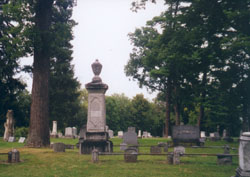 |
Martha died January 15, 1928, in St. Louis, Missouri. Martha was visiting her daughter Jane. She had never recovered from a fall, which caused a broken hip. She was eighty years old. At the time of her death her house was located at 400 South Michigan Avenue. Martha is buried with other family members at Oakwood Cemetery
Martha was referred to as a "Pioneer resident" of Saginaw (" Pioneer 10"). She was very active in her community. At her church she was an active member, ran her own business after first husband's death, and was a member of an all men's club. Martha was a role model for women of her time--and for our time also. Martha Hay Ayres was a leading member of her church and her community.
Timeline of Martha and James Hay, Eben Ayres and Family
1828 James Hay born May 10, 1828, in Scotland
1838 James moved to Warwick, Canada with his family to a farm
1847 Martha Amy Hawkins born Dixboro, Michigan
1858 James Hay formed a partnership with Ezra Rust
1859 Rust & Hay firm was formed
1864 Martha married James Hay at 17 years old
1865 Rust, Eaton & Co. was formed (property in Zilwaukee Michigan)
1866 James H. Hay born October 16, 1866
1866 James H. Hay died August 27, 1866
1867 Mary Wetherell Hay born July 29, 1867
1869 Will Greive Hay born December 31, 1865
1871 Hay, Butman & Co. was organized (mill located in Bay City also handling salt works)
1871 Jane Hawkins Hay born October 15, 1871
1873 James Hay is director of Tittabawassee Boom Co.
1873 Andrew Hay married Lizzie Sutherland September 24, 1873 in Saginaw, Michigan.
1874 Martha Doyle Hay born February 13, 1874
1876 Alice Merrill Hay born September 5, 1876
1878 Ethel Rust Hay March 29, 1878
1876 James Hay was elected president of the Tittabawassee Boom Co.
1881 James Hay died November 25, 1881
1877 Alice M. Hay died September 5, 1877
1882 Nina James Hay born March 19, 1882
1880 Blanche Palmer Hay born February 29, 1881
1889 Mary Wetherell Hay married Edward Alfred Owen October 15, 1889
1894 Jane Hawkins Hay married Harry Joseph Cummings May 30, 1894
1887 Martha built her home on 400 Washington (400 S. Michigan)
1894 Will Grieve Hay married Emma Linder November 16, 1894
1895 Martha Doyle Hay married John A. Weir October 22, 1895
1891 Ayres Lumber and Salt Company incorporated January 1, 1891
1896 Martha Hay married Ebenezer R. Ayres March 17, 1896
1898 Rust, Eaton & Co. dissolution 1898
1898 Ethel Rust Hay married October 19, 1898
1900 Martha Hay Weir O'Reilly died June 4, 1900
1902 Blanche Palmer Hay Married Thomas William O'Reilly March 5, 1902
1902 John Kilby Cummings born July 18, 1902 (son of Jane Hay)
1903 Thomas W. O'Reilly born May 2, 1903 (son of Blanche Hay)
1903 Nina James Hay married Louis Penoyer Ramsey June 17, 1903
1903 Andrew Hay died September 17, 1903 (brother of James Hay)
1905 Martha Hay Ramsey born June 20, 1905 (daughter of Nina Hay)
1908 Margaret O. Forestall born January 31, 1908 (daughter of Will Hay)
1912 Mary Archer O'Reilly born December 8, 1912
1913 Martha Ann Cummings born March 29, 1913 (daughter of Jane Hay)
1914 E. R. Ayres died January 17, 1914
1915 Verra Lucilla Cummings born May 15, 1915
1916 Barbara O'Reilly born July 28, 1916 (daughter of Blanche Hay)
1928 Martha Hay Ayres died January 17, 1928 (St. Louis, Missouri, at Jane Cummings' house)
1951 Will G. Hay died January 25, 1951
1968 Margaret O. Hay died July 28, 1968
Works Cited
- "A Quiet Wedding." Saginaw Evening News 23, Oct. 1895: 7.
- " Deaths." St. Louis Post-Dispatch. 16 Jan. 1928: 19.
- Gross, Stuart. Frankie and the Barons. Fowlerville, MI.: Wilderness Press, 1991.
- "Hay-Ramsey." Saginaw Currier Herald. 1. Jun. 1903: 7.
- Kilar, Jeremy. Saginaw Changeable Past: An Illustrated History. St. Louis, MO.: G. Bradley Pub. Inc., 1995
- "Laid At Rest" Saginaw Herald. 1, Dec. 1881: 01.
- Main International Genealogical Index 4.01--North America. Intellectual Reserve, Inc
1980, 1997 - "Marriage Licenses." Saginaw Evening News. 21 Oct. 1898:8.
- Meek, Forrest. Michigan's Timber Battleground. Clare County Bicentennial Historical Committee, 1976.
- Mills, James Cooke. Portrait & Biographical Record of Saginaw & Bay Counties. Chicago, 1892. Microfilm # 157 360-370.
- - - - . History of Saginaw County Michigan, Vol. 1. Saginaw, MI.: Seeman & Peters, 1918.
- "Pioneer Resident, Mrs. Ayres Dead." Saginaw Daily News. 17 Jan. 1928: 10.
- Record of Marriage. Record # J-5818. State of Michigan, County of Saginaw, 1999.
- R L. Polk & Co. Saginaw City Directory. Detroit, MI: R. L. Polk & Co., 1877,1879, 1881,1884,1886,1887-8, 1889,1892,1893,1894,1895,1896,1914,1915.
- Saginaw City Directory, East Saginaw, Michigan. Enterprise Steam Printing House, 1869.
- Saginaw Genealogical Society. History of Saginaw County Michigan. Chicago: Chas, C
Chapman& Co., 1881. - Strobel, Ralph W. Tittabawassee River Log Marks. Saginaw, MI.: 1967.
- Saginaw 1857-1907 Semi-Centennial Souvenir. Saginaw, MI: The Board of Trade, 1907.
- The SanBorn Fire Insurance Maps. New York: F. W. Bears & Co., !877, 1901.
- "To Atlantic City." Saginaw Evening News. 28 Jul. 1902: 7.
Photo credits:
Martha Hay Photo - Historical Society of Saginaw County, Inc.; Oakwood Cemetery Photos - Mary B. Looby; Saginaw Homes Photo - Hoyt Library, Eddy Historical and Genealogical Collection
| The written and visual works in Mid-Michigan Remembers-Stories about Us were chosen on the basis of their quality, diversity, community interest and appeal. Views expressed do not necessarily reflect those of the College. This space is provided as a service by Delta College. |